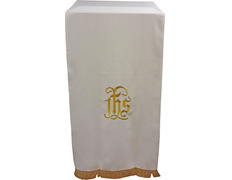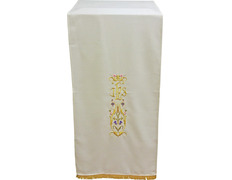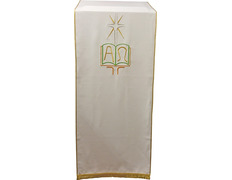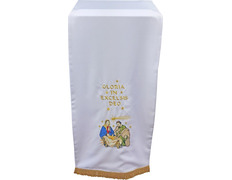The altar of a church is a fundamental space within a Catholic temple. In the altar area, different pieces of parish furniture are located. Among all these elements, the lectern and the ambo stand out.
These two elements have been confused as they have similar shapes, but they have distinctive features that differentiate them.
Thus, we can say that a lectern is a piece of religious furniture used daily in our churches and has the particularity of being mobile. It can be located in different places within the altar.
We can find lecterns made of wood, bronze, metal, and other materials.
Meanwhile, the pulpit is a more significant element that is usually always located in the same place.
Both elements have great relevance in parish liturgical celebrations. For this reason, they are often decorated with cloths, blankets or veils known as lectern covers or lectern veils, in the point that they are placed on a lectern; or pulpit covers or ambo veils, in the case that they cover an pulpit scarf. The name of the veil that covers the podium may vary depending on the region.
Regardless of what it is called, the purpose of these cloths or veils that cover the ambos is to accentuate the importance of the space from which the divine word is transmitted.
This veil or cloth that covers the podium is often decorated with religious motifs or symbolic figures. Its colors can change depending on the liturgical season.
Buying lectern covers is a process in which we must consider several factors.
First, it is vital to consider where we place the order to make the purchase. The appearance of online stores with home delivery with Brabander Religious Articles has opened up a new world of possibilities for buyers. People from any region can receive their purchase at home or parish at competitive prices, with a total delivery guarantee and in tight time frames.
Another factor to take into account is the measurements of the ambo veil which are the measurements. The height and width of the ambo or lectern must considered so that the cloth is proportionate to the piece of furniture.
Price is another of the characteristics to take into account. There is a wide variety of products and prices in a catalog of Catholic religious ornaments like our online store. The buyer must look for the price that best suits their budget.
The embroidery and weaving of the cloths is another critical attribute. We can see a wide variety of liturgical motifs embroidered on a lectern cloth: golden ear, grapes, chalices, Tau Cross, figure of the Virgin Mary, Pantocrator, JHS, and other embroideries.
If you want to buy lectern cloth, especially designed for church lecterns, at Brabander Catholic Products you will find a wide variety to meet your needs.
We have an extensive catalog of liturgical and Easter brotherhood ornaments of different qualities and finishes. Various fabrics, embroideries and colors.
In addition, we have developed a straightforward purchasing process with two shipping alternatives: home delivery and UPS pickup point.
Finally, we offer many of payment methods to close your purchase: Paypal, credit card and bank transfer.
You find everything you need to have an safe online shopping experience in our online store.
Brabander Religious Articles has specialized in the delivery of orders to any region.
If, for example, you reside in United States, you can easily place an order from your mobile, tablet or computer. You need to visit our online store's website, select the best product and purchase.
Once you place your order, our home delivery services will ensure you receive your purchase in optimal condition. Personally visiting physical stores is no longer necessary since you can acquire the lectern cloth from the comfort of your home or parish.
The price of an ambo cover can vary depending on the quality of the material (the fabric) and the design.
The fabric is the first factor that modifies the sale price of the clothes. The cheapest ambo covers are those made of polyester and some other high-quality material, such as viscose or satin.
Regarding the design, we must bear in mind that embroidery is the factor that has the most significant weight on the price. Embroideries are basically of two types: machine embroideries and hand embroideries.
Machine embroidery is a technique for decorating garments and clothes that consists of ornamenting textiles with colored threads using a specialized machine. This technique allows you to create detailed and precise designs, adding a unique touch. Machine embroideries offer various creative possibilities since different types of threads, stitches and patterns can be used to achieve customized and original results. It is a manufacturing method limited by embroidery patterns, before making a new embroidery on a cloth, it is necessary to create a design on the machine to perform the embroidery.
Hand embroidery is the traditional way of decorating fabrics and garments. This ancient technique has been used for centuries to embellish all kinds of textiles. Hand embroideries require the skill and patience of an embroiderer since each stitch is carefully made with a needle and thread. In addition to their aesthetic beauty, they have an intrinsic artistic value since each one is a unique piece. A hand-embroidered ambo cover is much more expensive than a machine-embroidered cloth since it is a complete artisan process.
The liturgical colors of the lectern covers play a crucial role in expressing and representing the different phases and festivities of the liturgical calendar. These colors not only embellish the lectern but also indicate the various moments in the life of Christ and the Church.
The red lectern cover is an iconic liturgical element used in the Catholic Church during Holy Week, the feast of Pentecost and other celebrations related to the Holy Spirit, representing the blood of Christ, martyrdom and the fire of Christian charity.
It is common to place a red ambo cloth during celebrations of the Apostles, Evangelists and martyr Saints.
The white lectern cloth is a white fabric cover placed on the lectern in the church during specific liturgical periods. It is especially prominent during Easter and Christmas, symbolizing the purity and holiness of these times in the ecclesiastical calendar.
White vestments are also used during Marian celebrations of the Virgin Mary (white Marian lectern cover), the feasts of the Angels and non-martyr Saints.
The sacraments of Baptism, Confirmation, Anointing of the Sick, Holy Orders and Matrimony are other celebrations in which it is common to decorate the altars with white cloths.
The green lectern cloth is an essential liturgical element used in the celebrations of the Catholic Church. They are used during the ordinary time of the Liturgical Year when no particular feast is celebrated.
The embroidered or plain green lectern cover occupies its space during ordinary time, from the Feast of the Baptism of the Lord to Lent and Pentecost to Advent.
The purple ambo cover is a ceremonial piece used in the liturgy of the Catholic Church, especially during periods such as Lent and Advent, symbolizing penance, humility and preparation. This ambo cover is placed on the podium covers, giving a touch of solemnity and reverence to the sacred space.
In addition, purple vestments are also used during Holy Week celebrations and in requiem Masses.
The pink lectern cloth is one of the liturgical elements used in religious celebrations. It symbolizes the joy and hope experienced in the penitential periods of Advent and Lent.
In Advent, the pink ambo cover is used on the third Sunday, Gaudete Sunday.
The priests and pastors of the Catholic Church can also decorate the altars with pink vestments on the fourth Sunday of Lent.
Lectern covers are decorative elements of churches used to cover the lecterns where the reading of the Bible is placed. There are different lectern covers, each with a particular spiritual meaning.
The classification presented below is based on different decorative elements linked to the Catholic Church and is full of symbolism for all the faithful.
The lectern cover of the Holy Spirit wasusually red but, today, they are sold in all colors.
The symbols that usually decorate this type of cloth are the White Dove and the seven gifts of the Holy Spirit accompanied by tongues of fire.
It symbolizes the divine protection the Holy Spirit offers the faithful with his presence.
The Virgin Mary's lectern cover is an essential object in the Catholic tradition.
Marian clothes are usually made of white or blue fabric, representing purity and devotion to the Virgin Mary.
Churches and parishes are usually decorated with vestments decorated with Marian figures and images during Masses of the Immaculate Conception, the day of Our Lady of Guadalupe, the feast of the Assumption of Mary, the Annunciation, etc.
Printed lectern covers are religious accessories used in the Church to dress the lecterns found on the altar. With exceptional designs and prints, these clothes represent different figures and symbols sacred to the Catholic religion.
The lectern cover of the Burning Bush of Mary is a piece of great religious and symbolic value. Christian Tradition interprets the burning bush as a prefiguration of the incarnation of Jesus in the virginal womb of Mary. The Virgin Mary and her virginity are associated with the bush that burns and does not consume.
Authors such as Saint Gregory of Nyssa already speak of this symbolism, directly comparing the bush that does not consume with Mary's preserved virginity.
Liturgy and art also represent this symbolic interpretation of the bush.
Lectern covers, as a decorative and symbolic element within the altar, can be of two types.
Embroidered lectern covers or plain lectern covers without any embroidery.
Both options are usually used in parishes depending on the liturgical celebration.
Plain lectern covers are an elegant and straightforward option to embellish the lecterns used in churches and chapels. These cloths, also known as unembroidered lectern covers, have a plain, unadorned design, which gives them a minimalist and sophisticated look.
By not having embroideries or decorative details, plain lectern covers are versatile and adapt perfectly to any style of decoration or lectern design. They can be combined with other liturgical elements, such as crosses, candelabra or flower crowns, without overshadowing their beauty or excessive ornamentation.
The symbolism of plain lectern covers is concentrated in the fabric's color (the 4 liturgical colors). It is common nowadays to buy the altar cloth that covers the altar table in the same color as the lectern covers and altar sets to provide further homogeneity to the liturgical celebration.
Embroidered lectern covers are a beautiful way to decorate altars and pulpit scarves in churches. The embroideries on lectern covers can be of different methods and styles, from traditional religious designs to more modern and abstract designs.
In addition to embroidered lectern covers, there are plain lectern covers with no decoration or embroidery.
These embroidered lectern cloth can have different religious designs and embroideries, such as Christian symbols, images of Saints, Marian symbols or anagrams, Christ symbols (embroidered Cross, Perpetual Help or the JHS embroidered in golden thread), Eucharistic elements, liturgical elements (Cross, wheat stalks and grapes), passages from the Bible (Adoration of the Magi), symbols of the Holy Spirit, etc.
In church altars, it is common to see a St. Joseph lectern cloth, a Virgin Mary lectern cloth, a Cross lectern cover, etc.
It is also possible to make the ambo cover with drawings that fit the theme or the liturgical season, such as floral motifs for Easter or Christmas motifs for Christmas.
Lectern cover fabrics are specifically designed to meet the needs of this type of accessory. Made with high-quality materials such as polyester, silk or velvet, these fabrics offer excellent durability and wear resistance, which guaranteeing prolonged use without losing their original appearance.
In addition to their durability, lectern cover fabrics have a wide range of colors, allowing users to customize their settings and adapt them to the different celebrations of the liturgical calendar. From smooth, shiny fabrics to fabrics with elegant prints, the variety of options allows the creation of lectern covers that fit perfectly with the decoration of the altar.
Lectern covers and puplit covers are elements used in the celebrations of the Neocatechumenal Way.
The lectern covers of the Neocatechumenal Way are usually liturgical colors, such as white, red or green, and they typically have embroidered religious symbols or words related to the liturgy. The embroidered lectern covers of the Neocatechumenal Way are made with great attention to detail and are considered a symbol of reverence and respect for the Word of God.
In addition, ambo covers are also used in the Neocatechumenal Way. These podium covers are fabric pieces placed on the ambo, or pulpit, during preaching and homilies. Like the lectern covers, these ambo covers of the Neocatechumenal Way are usually liturgical colors and have embroidered religious symbols. These liturgical elements play an essential role in the celebrations of the Neocatechumenal Way, as they help create a sacred and respectful environment during readings and preaching.
In the Neocatechumenal Way, several religious symbols are used that have a special meaning for the members of this community. Some of the main icons are:
The Icon of the Good Shepherd. This icon represents Jesus as the Good Shepherd who cares for and guides his flock. It is a reminder of Christ's closeness and love for each person. The icon of the Good Shepherd is venerated and used in the liturgical celebrations of the Neocatechumenal Way.
The Icon of the Holy Family. This icon represents the Holy Family of Nazareth: Jesus, Virgin Mary and Saint Joseph. It symbolizes importance of family in Christian life and is a model for families that are part of the Neocatechumenal Way.
The Icon of the Paschal Lamb: This icon represents Jesus as the Lamb of God who takes away the world's sin. It is a symbol of redemption and Christ's sacrifice on the cross. The icon of the Paschal Lamb is used in the liturgy of the Neocatechumenal Way, especially during the celebration of the Eucharist.
The Cross. The cross is a central symbol in the Christian faith and has a vital place in the Neocatechumenal Way. It represents Jesus' sacrifice for the salvation of humanity and the call to take up our cross and follow Christ. The cross is used in liturgical celebrations and worn as a distinctive sign on the chest during pilgrimages and missions.
Christ Pantocrator. Christ is the Almighty who comes in the glory of his divinity. In this icon, Christ is shown in white garments and carries in his left hand the Book of Life, in which one reads, "Love your enemies" and "I am coming soon." With his right hand, he blesses.
These are some of the main religious symbols used in the Neocatechumenal Way. Each one has a profound meaning and helps members of this community deepen their faith and live their Christian vocation.
The Neocatechumenal Way was initiated in 1964 by Francisco (Kiko) Argüello and Carmen Hernández in Madrid's shantytowns of Palomeras Altas. At the request of the poor with whom they lived, they began to announce the Gospel of Jesus Christ to them.
Over time, this proclamation took shape in a catechetical synthesis based on the word of God, the liturgy and the community to lead people to fraternal communion and mature faith.
This evangelization experience was welcomed positively by the then archbishop of Madrid, Monsignor Casimiro Morcillo, who encouraged the initiators of the Way to spread it to the requested parishes. Since then, this evangelization experience has gradually spread in the Archdiocese of Madrid and other Spanish dioceses.
Francisco José Gómez de Argüello Wirtz, known as Kiko Argüello, was born on January 9, 1939 in León, Spain. He studied Fine Arts at the San Fernando Academy in Madrid and received the National Extraordinary Painting Award in 1959. However, after experiencing a profound existential crisis, he had a conversion that led him to dedicate his life to Jesus Christ and the Church.
In 1960, with the sculptor Coomontes and the glassmaker Muñoz de Pablos, he founded the research and development group of Sacred Art called "Gremio 62". He held exhibitions in Madrid and represented Spain at the Universal Exhibition of Sacred Art in Royan, France, 1964. He also exhibited in the Netherlands in 1965.
Convinced that Christ is present in the suffering of the innocent and the downtrodden, in 1964, he decided to go and live among the poor. He settled in a shack in Palomeras Altas, on the outskirts of Madrid. In this context, he had a spiritual experience in which he discovered the mystery of the Crucified Christ present in those most in need.
Kiko Argüello received inspiration from the Virgin Mary, who showed him the importance of forming Christian communities based on humility, simplicity and praise, like the Holy Family of Nazareth. From this experience, with Carmen Hernández, he founded the Neocatechumenal Way, an evangelization initiative that has spread worldwide.
It is essential to highlight that Kiko Argüello is recognized for his contribution to sacred art and his commitment to evangelization through the Neocatechumenal Way.
María Carmen Hernández Barrera, born on February 24, 1930 in Órgiva, Spain, was a prominent figure in the Catholic Church and co-founder of the Neocatechumenal Way together with Kiko Argüello. After studying Chemistry in Madrid, she decided to devote herself to the mission of the Catholic Church and retired to the Institute of Missionaries of Christ Jesus.
She obtained a degree in Theology and, inspired by the Second Vatican Council, spent two years in Israel to deepen her understanding of the Bible and the importance of catechesis. Upon her return to Spain, she witnessed the first catechumenal community in Palomeras Altas, in the suburbs of Madrid, and joined that group coordinated by Kiko Argüello.
Carmen Hernández and Kiko Argüello, inspired by the charism of Charles de Foucauld, sought to make themselves present among the poor and bring the announcement of the Good News to all places, especially the most marginalized. Her work in founding and developing the Neocatechumenal Way has been fundamental to its worldwide expansion.
Throughout her life, Carmen Hernández rejected honorary titles and awards but accepted an honorary degree from the Catholic University of America in Washington DC in 2015, recognizing her dedication to the poor and her work for the Church. She passed away on July 19, 2016 at 85.
Carmen Hernández left a legacy of love for Jesus, missionary enthusiasm and dedication to the Church. Her testimony and work in evangelization continue to be remembered and valued by the Catholic community.
Lectern cloths, lectern covers or podium cover are intended to adorn the place where the reading of the Holy Bible is proclaimed at Mass and other Catholic ceremonies.

Ref: 84FK01

Ref: 84FK01

Ref: 84FK01

Ref: 84FK01

Ref: 84FK01

Ref: 56B005

Ref: 56B003

Ref: 84FK02

Ref: 56B004

Ref: 56B002

Ref: 1F4004

Ref: 1F4004

Ref: 1F4004

Ref: 1F4004

Ref: 52F328

Ref: 52F328

Ref: 52F328

Ref: 52F328

Ref: 1F84023

Ref: 1F84023

Ref: 1F84063

Ref: 1F84023

Ref: 1F84063

Ref: 1F84063

Ref: 52F328

Ref: 52F328

Ref: 56R714

Ref: 52F333

Ref: 52F333

Ref: 52F333

Ref: 52F333

Ref: 56F891

Ref: 56F891

Ref: 56B030

Ref: 52F323

Ref: 52F323

Ref: 52F323

Ref: 52F323

Ref: 56B21104

Ref: 56B2111

Ref: 56B047

Ref: 84F394

Ref: 56F891

Ref: 56F891

Ref: 1F84023

Ref: 84B030

Ref: 1F84063